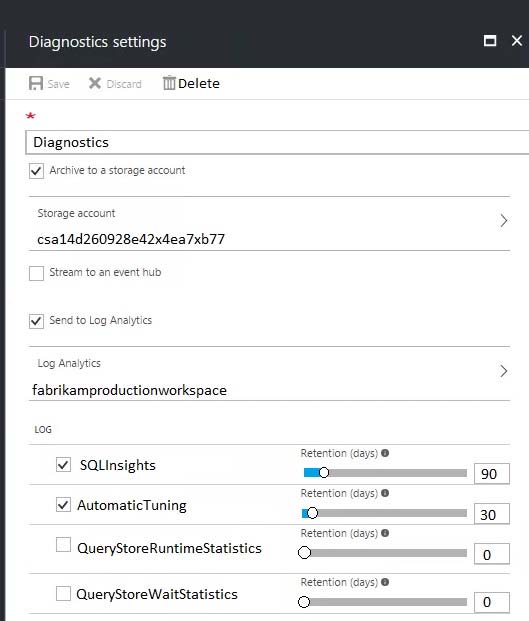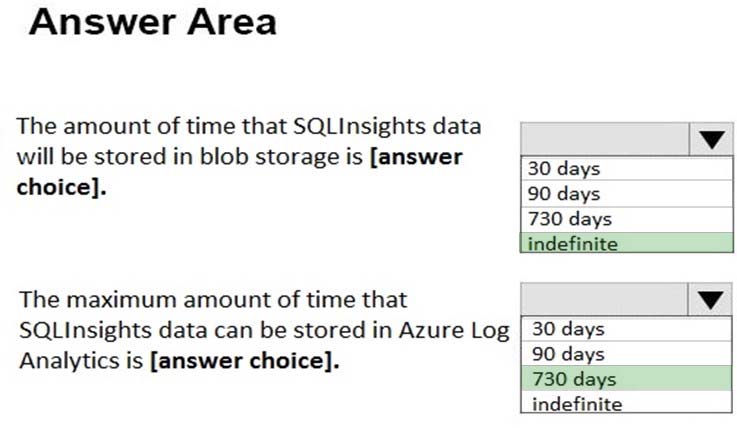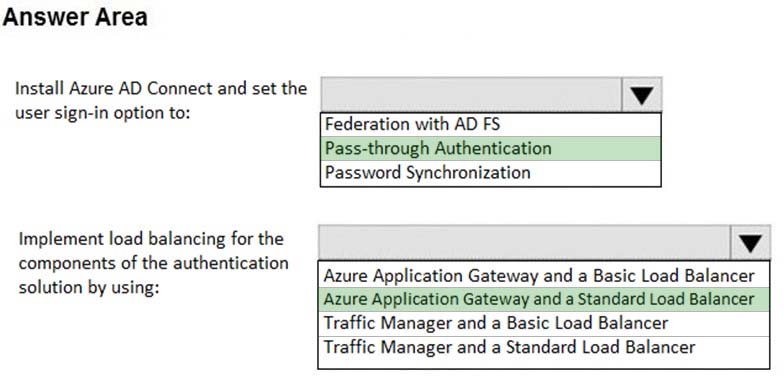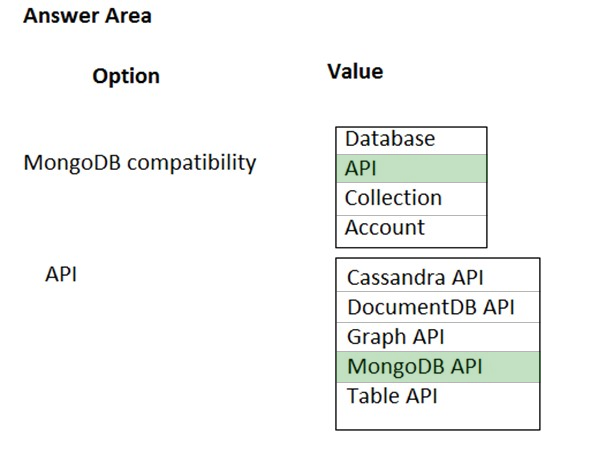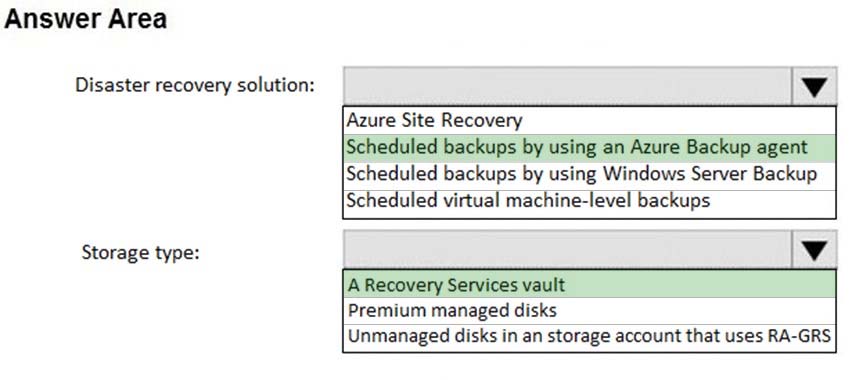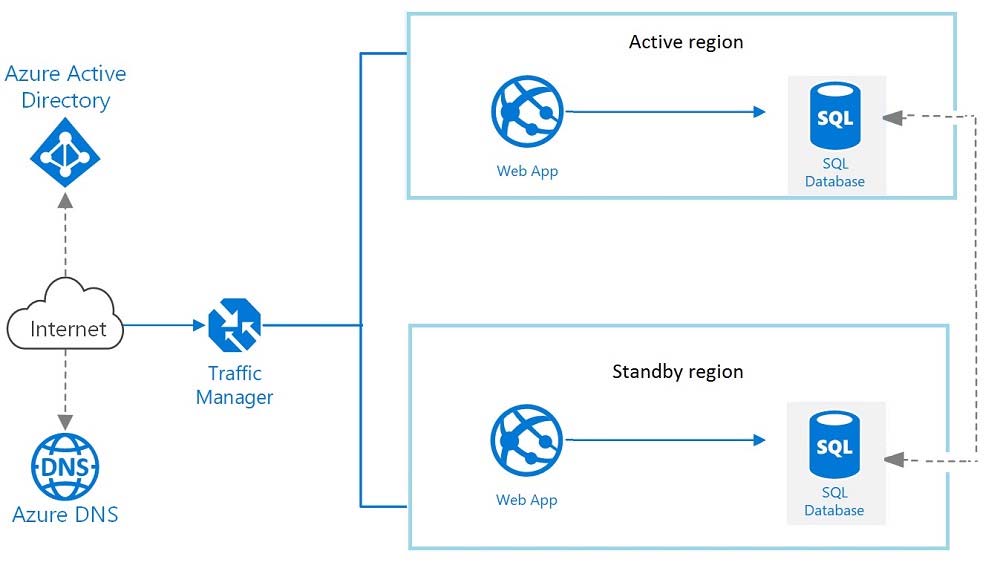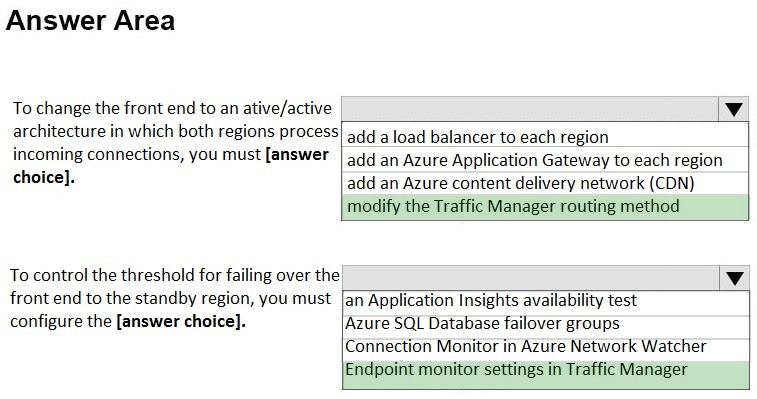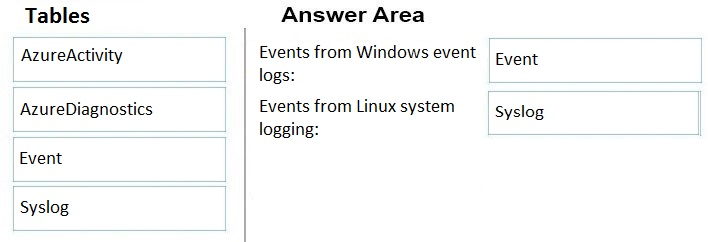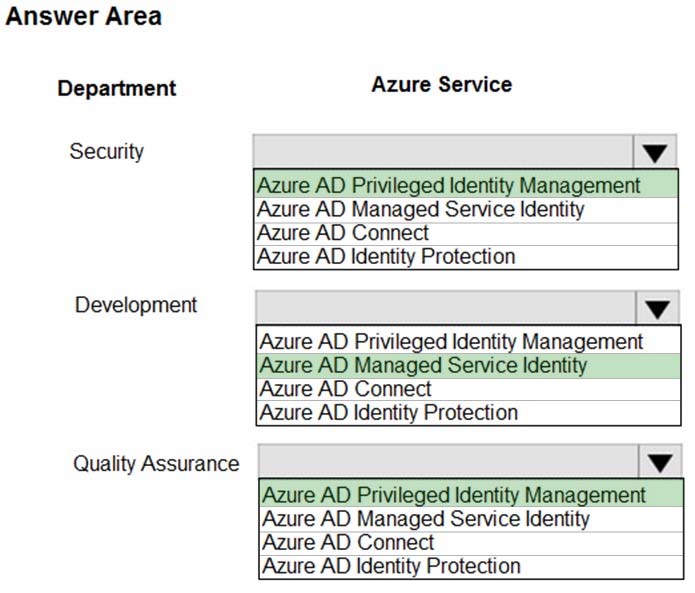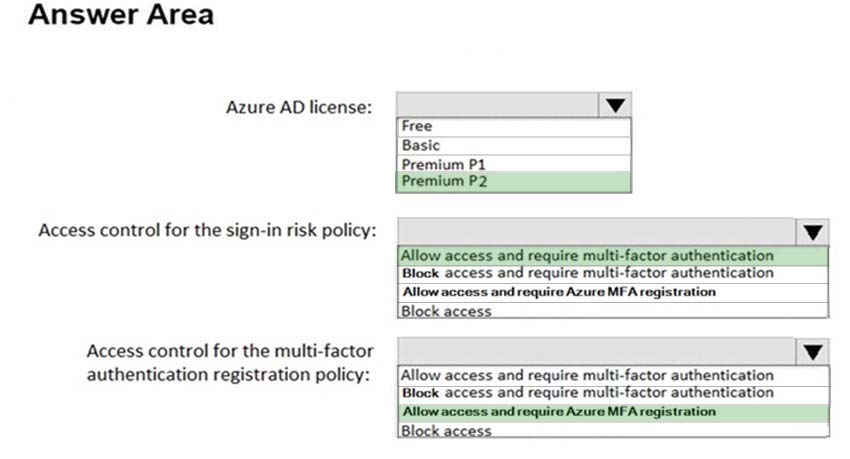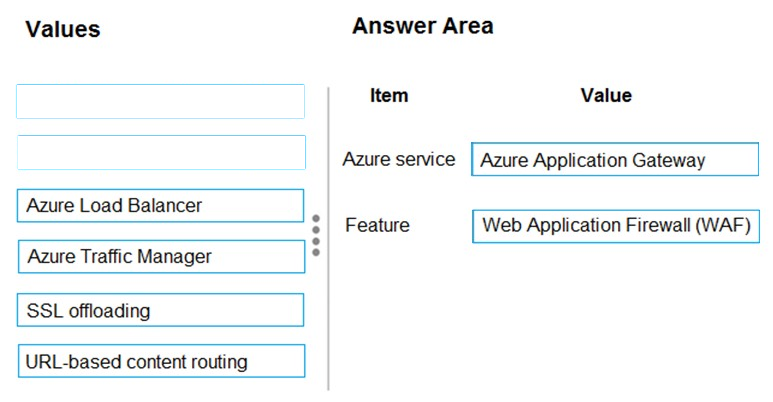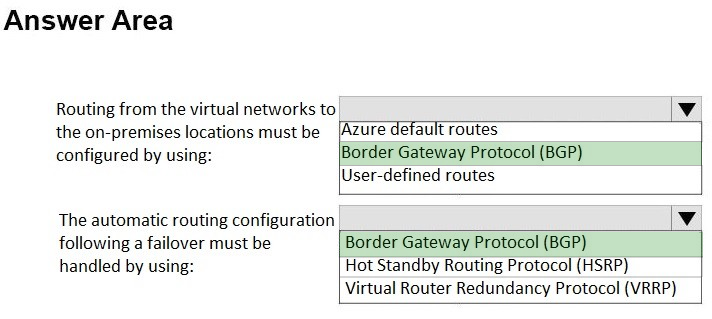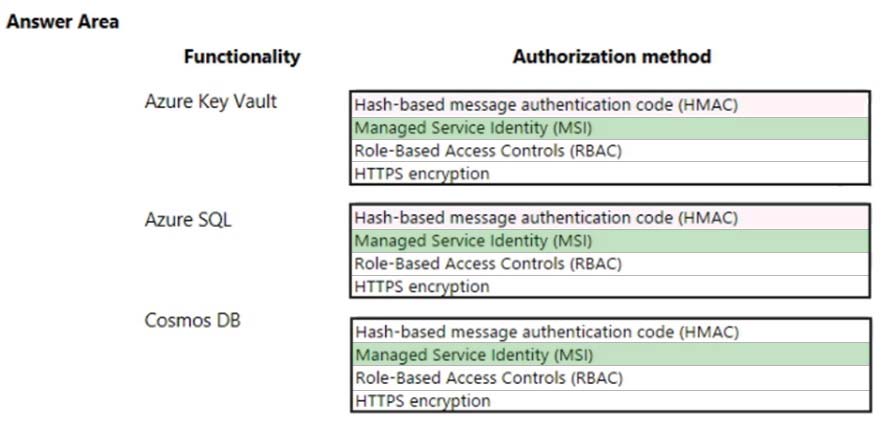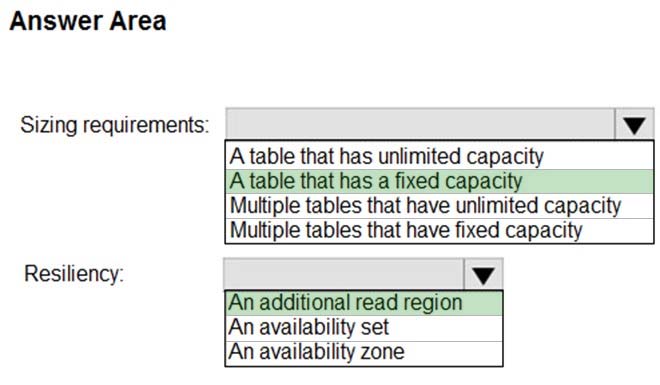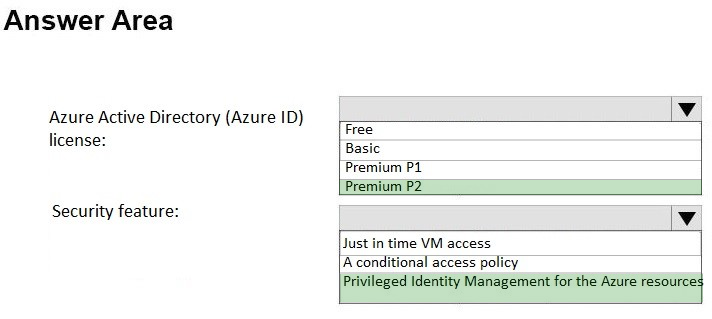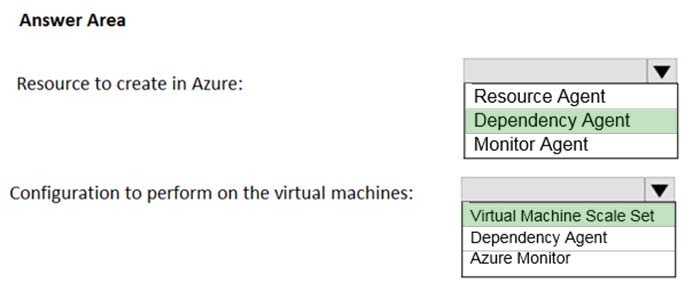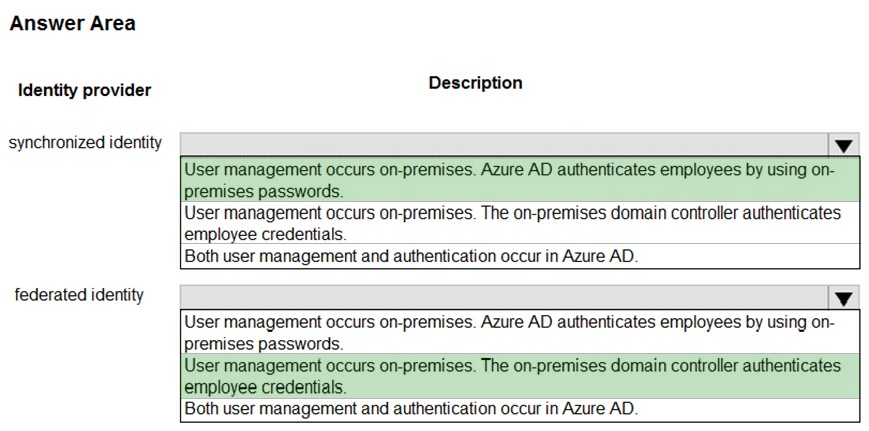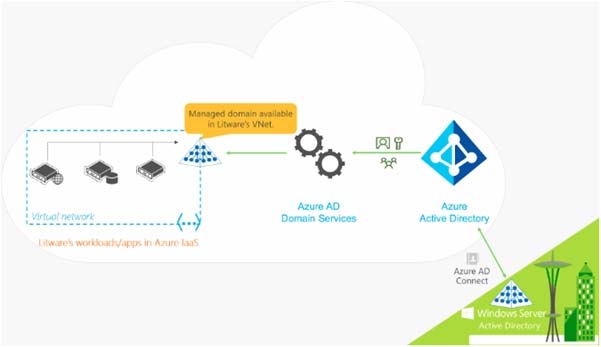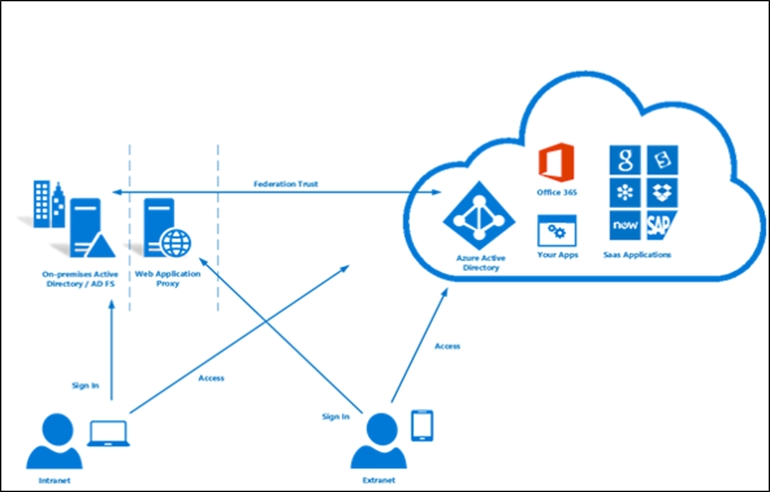AZ-301 Practice Test Free – 50 Real Exam Questions to Boost Your Confidence
Preparing for the AZ-301 exam? Start with our AZ-301 Practice Test Free – a set of 50 high-quality, exam-style questions crafted to help you assess your knowledge and improve your chances of passing on the first try.
Taking a AZ-301 practice test free is one of the smartest ways to:
- Get familiar with the real exam format and question types
- Evaluate your strengths and spot knowledge gaps
- Gain the confidence you need to succeed on exam day
Below, you will find 50 free AZ-301 practice questions to help you prepare for the exam. These questions are designed to reflect the real exam structure and difficulty level. You can click on each Question to explore the details.
HOTSPOT -
You deploy several Azure SQL Database instances.
You plan to configure the Diagnostics settings on the databases as shown in the following exhibit.
Use the drop-down menus to select the answer choice that completes each statement based on the information presented in the graphic.
NOTE: Each correct selection is worth one point.
Hot Area:
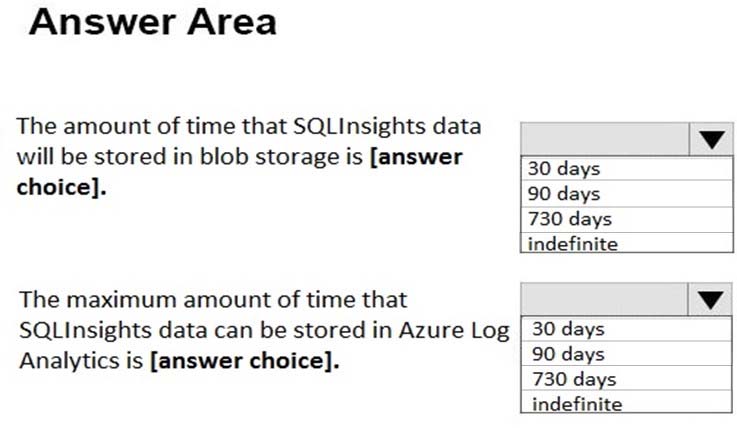
You have a .NET web service named Service1 that has the following requirements:
✑ Must read and write temporary files to the local file system.
✑ Must write to the Windows Application event log.
You need to recommend a solution to host Service1 in Azure. The solution must meet the following requirements:
✑ Minimize maintenance overhead.
✑ Minimize costs.
What should you include in the recommendation?A. an Azure virtual machine scale set
B. an Azure function
C. an App Service Environment
D. an Azure web app
You have 100 Microsoft SQL Server Integration Services (SSIS) packages that are configured to use 10 on-premises SQL Server databases as their destinations.
You plan to migrate the 10 on-premises databases to Azure SQL Database.
You need to recommend a solution to host the SSIS packages in Azure. The solution must ensure that the packages can target the SQL Database instances as their destinations.
What should you include in the recommendation?A. SQL Server Migration Assistant (SSMA)
B. Azure Data Factory
C. Data Migration Assistant
D. Azure Data Catalog
HOTSPOT -
To meet the authentication requirements of Fabrikam, what should you include in the solution? To answer, select the appropriate options in the answer area.
NOTE: Each correct selection is worth one point.
Hot Area:
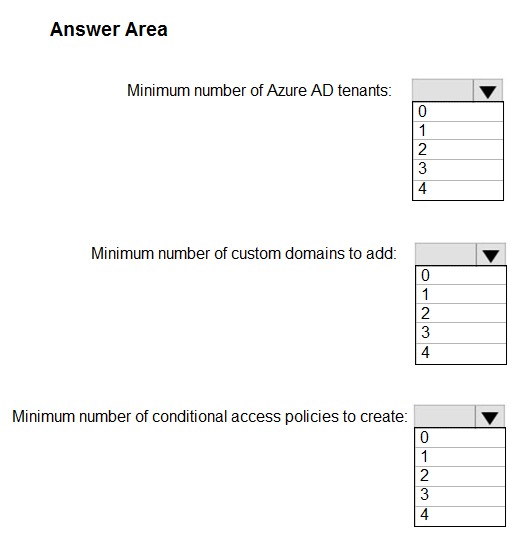
Note: This question is part of series of questions that present the same scenario. Each question in the series contains a unique solution that might meet the stated goals. Some question sets might have more than one correct solution, while others might not have a correct solution.
After you answer a question in this section, you will NOT be able to return to it. As a result, these questions will not appear in the review screen.
Your company has deployed several virtual machines (VMs) on-premises and to Azure. Azure ExpressRoute has been deployed and configured for on-premises to Azure connectivity.
Several VMs are exhibiting network connectivity issues.
You need to analyze the network traffic to determine whether packets are being allowed or denied to the VMs.
Solution: Use Azure Network Watcher to run IP flow verify to analyze the network traffic.
Does the solution meet the goal?A. Yes
B. No
You plan to deploy 200 Microsoft SQL Server databases to Azure by using Azure SQL Database and Azure SQL Database Managed Instance.
You need to recommend a monitoring solution that provides a consistent monitoring approach for all deployments. The solution must meet the following requirements:
✑ Support current-state analysis based on metrics collected near real-time, multiple times per minute, and maintained for up to one hour
✑ Support longer term analysis based on metrics collected multiple times per hour and maintained for up to two weeks.
✑ Support monitoring of the number of concurrent logins and concurrent sessions.
What should you include in the recommendation?A. dynamic management views
B. trace flags
C. Azure Monitor
D. SQL Server Profiler
DRAG DROP -
Your company identifies the following business continuity and disaster recovery objectives for virtual machines that host sales, finance, and reporting applications in the company's on-premises data center:
✑ The finance application requires that data be retained for seven years. In the event of a disaster, the application must be able to run from Azure. The recovery time objective (RTO) is 10 minutes.
✑ The reporting application must be able to recover point-in-time data at a daily granularity. The RTO is eight hours.
✑ The sales application must be able to fail over to a second on-premises data center.
You need to recommend which Azure services meet the business continuity and disaster recovery objectives. The solution must minimize costs.
What should you recommend for each application? To answer, drag the appropriate services to the correct applications. Each service may be used once, more than once, or not at all. You may need to drag the split bar between panes or scroll to view content.
NOTE: Each correct selection is worth one point.
Select and Place:

Note: This question is part of series of questions that present the same scenario. Each question in the series contains a unique solution that might meet the stated goals. Some question sets might have more than one correct solution, while others might not have a correct solution.
After you answer a question in this section, you will NOT be able to return to it. As a result, these questions will not appear in the review screen.
You need to deploy resources to host a stateless web app in an Azure subscription. The solution must meet the following requirements:
✑ Provide access to the full .NET framework.
✑ Provide redundancy if an Azure region fails.
✑ Grant administrators access to the operating system to install custom application dependencies.
Solution: You deploy an Azure virtual machine to two Azure regions, and you create a Traffic Manager profile.
Does this meet the goal?A. Yes
B. No
HOTSPOT -
You need to recommend a solution for the users at Contoso to authenticate to the cloud-based services and the Azure AD-integrated applications.
What should you include in the recommendation? To answer, select the appropriate options in the answer area.
NOTE: Each correct selection is worth one point.
Hot Area:
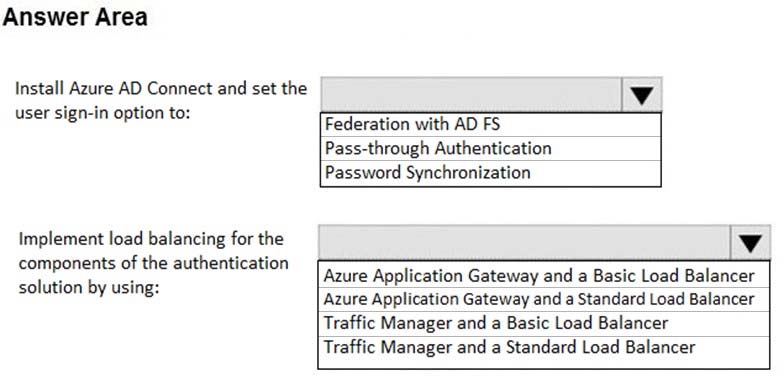
Note: This question is part of series of questions that present the same scenario. Each question in the series contains a unique solution that might meet the stated goals. Some question sets might have more than one correct solution, while others might not have a correct solution.
After you answer a question in this section, you will NOT be able to return to it. As a result, these questions will not appear in the review screen.
You are designing an Azure solution for a company that wants to move a .NET Core web application from an on-premises data center to Azure. The web application relies on a Microsoft SQL Server 2016 database on Windows Server 2016. The database server will not move to Azure.
A separate networking team is responsible for configuring network permissions.
The company uses Azure ExpressRoute and has an ExpressRoute gateway connected to an Azure virtual network named VNET1.
You need to recommend a solution for deploying the web application.
Solution: Deploy the web application to a web app hosted in a Premium App Service plan. Configure VNET Integration for the App Service plan.
Does this meet the goal?A. Yes
B. No
You have 100 servers that run Windows Server 2012 R2 and host Microsoft SQL Server 2012 R2 instances. The instances host databases that have the following characteristics:
✑ The largest database is currently 3 TB. None of the databases will ever exceed 4 TB.
✑ Stored procedures are implemented by using CLR.
You plan to move all the data from SQL Server to Azure.
You need to recommend an Azure service to host the databases. The solution must meet the following requirements:
✑ Whenever possible, minimize management overhead for the migrated databases.
✑ Minimize the number of database changes required to facilitate the migration.
✑ Ensure that users can authenticate by using their Active Directory credentials.
What should you include in the recommendation?A. Azure SQL Database single databases
B. Azure SQL Database Managed Instance
C. Azure SQL Database elastic pools
D. SQL Server 2016 on Azure virtual machines
Note: This question is part of series of questions that present the same scenario. Each question in the series contains a unique solution that might meet the stated goals. Some question sets might have more than one correct solution, while others might not have a correct solution.
After you answer a question in this section, you will NOT be able to return to it. As a result, these questions will not appear in the review screen.
You have an Azure subscription that contains a resource group named RG1.
You create an Azure Active Directory (Azure AD) group named ResearchUsers that contains the user accounts of all researchers.
You need to recommend a solution that meets the following requirements:
✑ The researchers must be allowed to create Azure virtual machines.
The researchers must only be able to create Azure virtual machines by using specific Azure Resource Manager templates.
Solution: Create a lab in Azure DevTest Lab. Configure the DevTest Labs settings. Assign the DevTest Labs User role to the ResearchUsers group.
Does this meet the goal?A. Yes
B. No
You plan to deploy a payroll system to Azure. The payroll system will use Azure virtual machines that run SUSE Linux Enterprise Server and Windows.
You need to recommend a business continuity solution for the payroll system. The solution must meet the following requirements:
✑ Minimize costs.
✑ Provide business continuity if an Azure region fails.
✑ Provide a recovery time objective (RTO) of 120 minutes.
✑ Provide a recovery point objective (RPO) of five minutes.
What should you include in the recommendation?A. Microsoft System Center Data Protection Manager (DPM)
B. Azure Site Recovery
C. unmanaged disks that use geo-redundant storage (GRS)
D. Azure Backup
Note: This question is part of series of questions that present the same scenario. Each question in the series contains a unique solution that might meet the stated goals. Some question sets might have more than one correct solution, while others might not have a correct solution.
After you answer a question in this section, you will NOT be able to return to it. As a result, these questions will not appear in the review screen.
Your company has deployed several virtual machines (VMs) on-premises and to Azure. Azure ExpressRoute has been deployed and configured for on-premises to Azure connectivity.
Several VMs are exhibiting network connectivity issues.
You need to analyze the network traffic to determine whether packets are being allowed or denied to the VMs.
Solution: Use the Azure traffic analytics solution in Azure Log Analytics to analyze the network traffic.
Does the solution meet the goal?A. Yes
B. No
You plan to deploy 10 applications to Azure. The applications will be deployed to two Azure Kubernetes Service (AKS) clusters. Each cluster will be deployed to a separate Azure region.
The application deployment must meet the following requirements:
✑ Ensure that the applications remain available if a single AKS cluster fails.
✑ Ensure that the connection traffic over the internet is encrypted by using SSL without having to configure SSL on each container instance.
Which Azure service should you include in the recommendation?A. Azure Front Door
B. Azure Traffic Manager
C. Azure Load Balancer
D. AKS ingress controller
Your company has an on-premises Windows HPC cluster. The cluster runs an intrinsically parallel, compute-intensive workload that performs financial risk modelling.
You plan to migrate the workload to Azure Batch.
You need to design a solution that will support the workload. The solution must meet the following requirements:
✑ Support the large-scale parallel execution of Azure Batch jobs.
✑ Minimize cost.
What should you include in the solution?A. Basic A-series virtual machines
B. low-priority virtual machines
C. burstable virtual machines
D. Azure virtual machine sizes that support the Message Passing Interface (MPI) API
HOTSPOT -
You have a web application that uses a MongoDB database. You plan to migrate the web application to Azure.
You must migrate to Cosmos DB while minimizing code and configuration changes.
You need to design the Cosmos DB configuration.
What should you recommend? To answer, select the appropriate values in the answer area.
NOTE: Each correct selection is worth one point.
Hot Area:
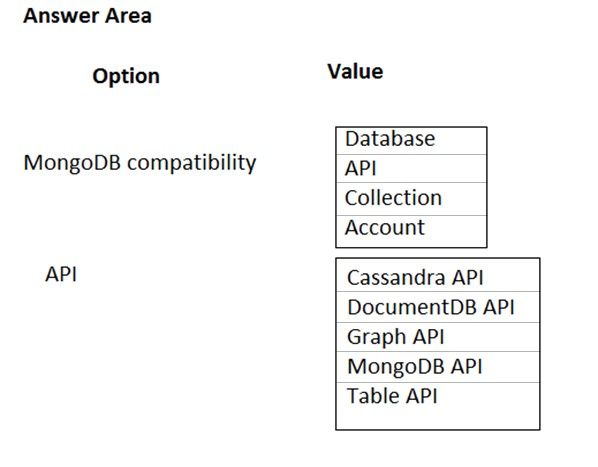
Note: This question is part of series of questions that present the same scenario. Each question in the series contains a unique solution that might meet the stated goals. Some question sets might have more than one correct solution, while others might not have a correct solution.
After you answer a question in this section, you will NOT be able to return to it. As a result, these questions will not appear in the review screen.
A company has custom ASP.NET and Java applications that run on old versions of Windows and Linux. The company plans to place applications in containers.
You need to design a solution that includes networking, service discovery, and load balancing for the applications. The solution must support storage orchestration.
Solution: You deploy each application to an Azure Web App that has container support.
Does the solution meet the goal?A. Yes
B. No
You are developing a sales application that will contain several Azure cloud services and will handle different components of a transactions. Different cloud services will process customer orders, billing, payment, inventory, and shipping.
You need to recommend a solution to enable the cloud services to asynchronously communicate transaction information by using REST messages.
What would you include in the recommendation?A. Traffic Manager
B. Azure Notification Hubs
C. Azure Blob storage
D. Azure Queue storage
You have Azure virtual machines that run a custom line-of-business web application.
You plan to use a third-party solution to parse event logs from the virtual machines stored in an Azure storage account.
You need to recommend a solution to save the event logs from the virtual machines to the Azure Storage account. The solution must minimize costs and complexity.
What should you include in the recommendation?A. Azure VM Diagnostics Extension
B. Azure Monitor
C. event log subscriptions
D. Azure Log Analytics
After you answer a question in this section, you will NOT be able to return to it. As a result, these questions will not appear in the review screen.
You have an Azure Storage v2 account named storage1.
You plan to archive data to storage1.
You need to ensure that the archived data cannot be deleted for five years. The solution must prevent administrators from deleting the data.
Solution: You create an Azure Blob storage container, and you configure a legal hold access policy.
Does this meet the goal?A. Yes
B. No
HOTSPOT -
You have 20 Azure virtual machines that run Windows Server 2016 based on a custom virtual machine image. Each virtual machine hosts an instance of a VSS- capable web app that was developed in-house. Each instance is accessed by using a public endpoint. Each instance uses a separate database. The average database size is 200 GB.
You need to design a disaster recovery solution for individual instances. The solution must meet the following requirements:
✑ Provide a recovery time objective (RTO) of six hours
✑ Provide a recovery point objective (RPO) of eight hours
✑ Support recovery to a different Azure region
✑ Support VSS-based backups
✑ Minimize costs
What should you include in the recommendation? To answer, select the appropriate options in the answer area.
NOTE: Each correct selection is worth one point.
Hot Area:
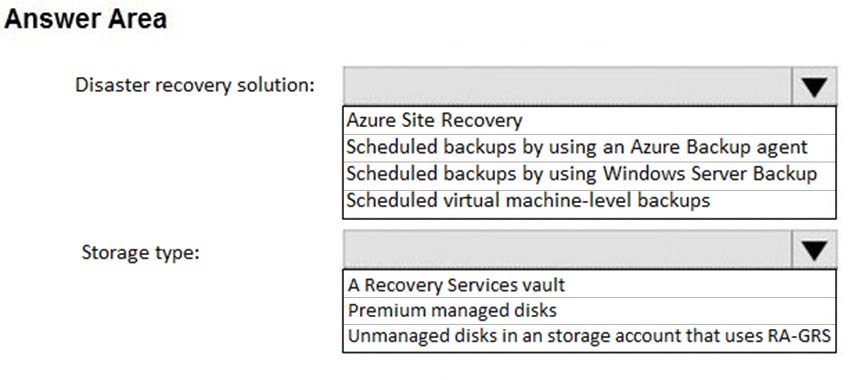
A partner manages on-premises and Azure environments. The partner deploys an on-premises solution that needs to use Azure services. The partner deploys a virtual appliance.
All network traffic that is directed to a specific subnet must flow through the virtual appliance.
You need to recommend solutions to manage network traffic.
Which two options should you recommend? Each correct answer presents a complete solution.
NOTE: Each correct selection is worth one point.A. Configure Azure Traffic Manager
B. Implement an Azure virtual network
C. Configure a routing table with forced tunneling
D. Implement Azure ExpressRoute
HOTSPOT -
You have the application architecture shown in the following exhibit.
Use the drop-down menus to select choice that completes each statement based on the information presented in the graphic.
NOTE: Each correct selection is worth one point.
Hot Area:
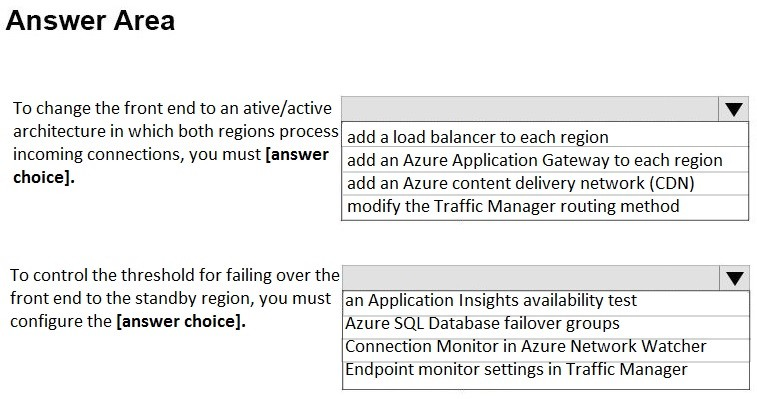
You are designing an Azure web app.
You need to ensure that users who have impaired vision can use the app.
Which reference material should you use when designing the app?A. Accessibility in Windows Dev Center
B. Azure Application Architecture Guide
C. Web Content Accessibility Guidelines
D. Cloud Application Architecture Guide
DRAG DROP -
You have an Azure subscription. The subscription contains Azure virtual machines that run Windows Server 2016 and Linux.
You need to use Azure Log Analytics design an alerting strategy for security-related events.
Which Log Analytics tables should you query? To answer, drag the appropriate tables to the correct log types. Each value may be used once, more than once, or not at all. You may need to drag the split bar between panes or scroll to view content.
NOTE: Each correct selection is worth one point.
Select and Place:
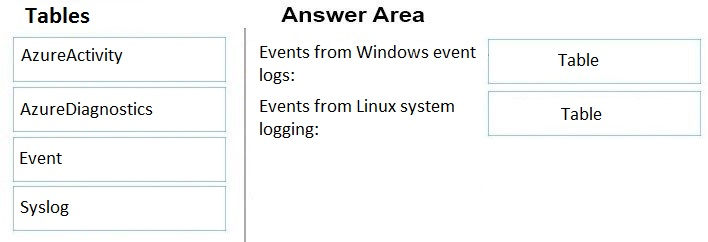
HOTSPOT -
Your organization has developed and deployed several Azure App Service Web and API applications. The applications use Azure Key Vault to store several authentication, storage account, and data encryption keys. Several departments have the following requests to support the applications:
You need to recommend the appropriate Azure service for each department request.
What should you recommend? To answer, configure the appropriate options in the dialog box in the answer area.
NOTE: Each correct selection is worth one point.
Hot Area:
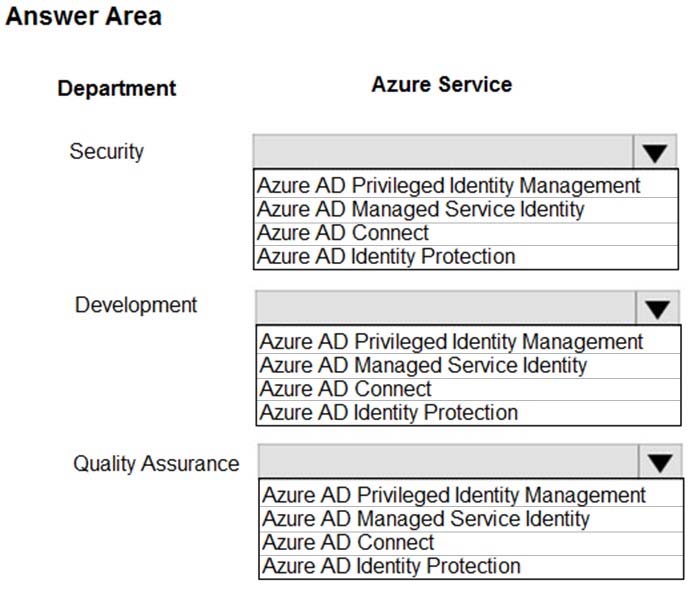
You manage a solution in Azure.
You must collect usage data including MAC addresses from all devices on the network.
You need to recommend a monitoring solution.
What should you recommend?A. Activity Log Analytics
B. Azure Network Security Group Analytics
C. Network Performance Monitor
D. Azure Application Gateway Analytics
E. Azure Wire Data
HOTSPOT -
You need to recommend a solution for configuring the Azure Multi-Factor Authentication (MFA) settings.
What should you include in the recommendation? To answer, select the appropriate options in the answer area.
NOTE: Each correct selection is worth one point.
Hot Area:
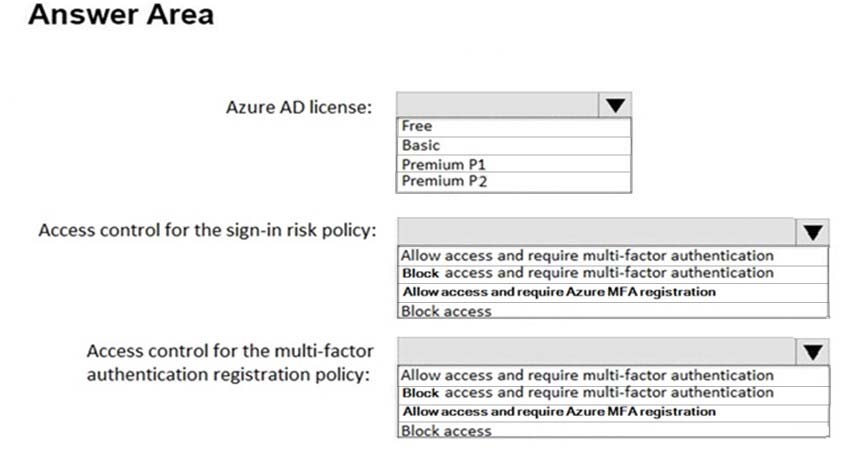
DRAG DROP -
A company has an existing web application that runs on virtual machines (VMs) in Azure.
You need to ensure that the application is protected from SQL injection attempts and uses a layer-7 load balancer. The solution must minimize disruption to the code for the existing web application.
What should you recommend? To answer, drag the appropriate values to the correct items. Each value may be used once, more than once, or not at all. You may need to drag the split bar between panes or scroll to view content.
NOTE: Each correct selection is worth one point.
Select and Place:
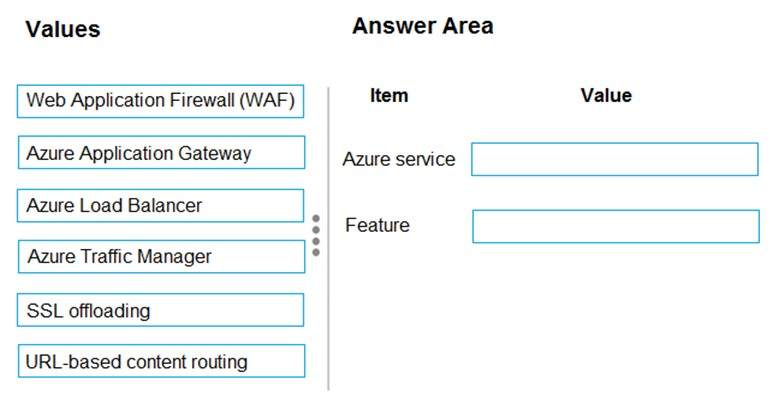
HOTSPOT -
Your company has two on-premises sites in New York and Los Angeles and Azure virtual networks in the East US Azure region and the West US Azure region.
Each on-premises site has Azure ExpressRoute circuits to both regions.
You need to recommend a solution that meets the following requirements:
✑ Outbound traffic to the Internet from workloads hosted on the virtual networks must be routed through the closest available on-premises site.
✑ If an on-premises site fails, traffic from the workloads on the virtual networks to the Internet must reroute automatically to the other site.
What should you include in the recommendation? To answer, select the appropriate options in the answer area.
NOTE: Each correct selection is worth one point.
Hot Area:
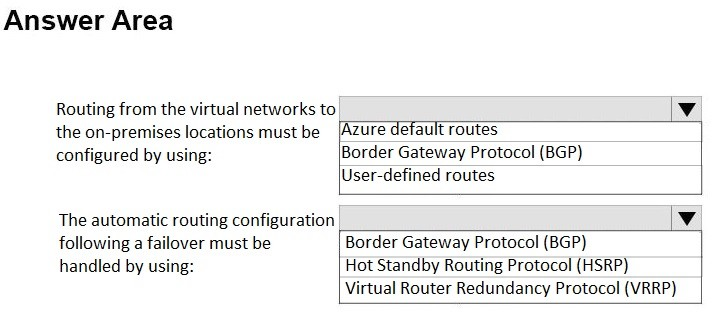
You use a virtual network to extend an on-premises IT environment into the cloud. The virtual network has two virtual machines (VMs) that store sensitive data.
The data must only be available using internal communication channels. Internet access to those VMs is not permitted.
You need to ensure that the VMs cannot access the Internet.
Which two options should you recommend? Each correct answer presents a complete solution.
NOTE: Each correct selection is worth one point.A. network interface (NIC)
B. Source Network Address Translation (SNAT)
C. Azure ExpressRoute
D. Network Security Groups (NSG)
You are designing an Azure solution.
The network traffic for the solution must be securely distributed by providing the following features:
✑ HTTPS protocol
✑ Round robin routing
✑ SSL offloading
You need to recommend a load balancing option.
What should you recommend?A. Azure Load Balancer
B. Azure Traffic Manager
C. Azure Internal Load Balancer (ILB)
D. Azure Application Gateway
You have an on-premises Hyper-V cluster. The cluster contains Hyper-V hosts that run Windows Server 2016 Datacenter. The hosts are licensed under a
Microsoft Enterprise Agreement that has Software Assurance.
The Hyper-V cluster hosts 3 virtual machines that run Windows Server 2012 R2. Each virtual machine runs a different workload. The workloads have predictable consumption patterns.
You plan to replace the virtual machines with Azure virtual machines that run Windows Server 2016. The virtual machines will be sized according to the consumption pattern of each workload.
You need to recommend a solution to minimize the compute costs of the Azure virtual machines.
Which two recommendations should you include in the solution? Each correct answer presents part of the solution.
NOTE: Each correct selection is worth one point.A. Purchase Azure Reserved Virtual Machine Instances for the Azure virtual machines
B. Create a virtual machine scale set that uses autoscaling
C. Configure a spending limit in the Azure account center
D. Create a lab in Azure DevTest Labs and place the Azure virtual machines in the lab
E. Activate Azure Hybrid Benefit for the Azure virtual machines
HOTSPOT -
You are building an application that will run in a virtual machine (VM). The application will use Managed Service Identity (MSI).
The application uses Azure Key Vault, Azure SQL Database, and Azure Cosmos DB.
You need to ensure the application can use secure credentials to access these services.
Which authorization methods should you recommend? To answer, select the appropriate options in the answer area.
NOTE: Each correct selection is worth one point.
Hot Area:
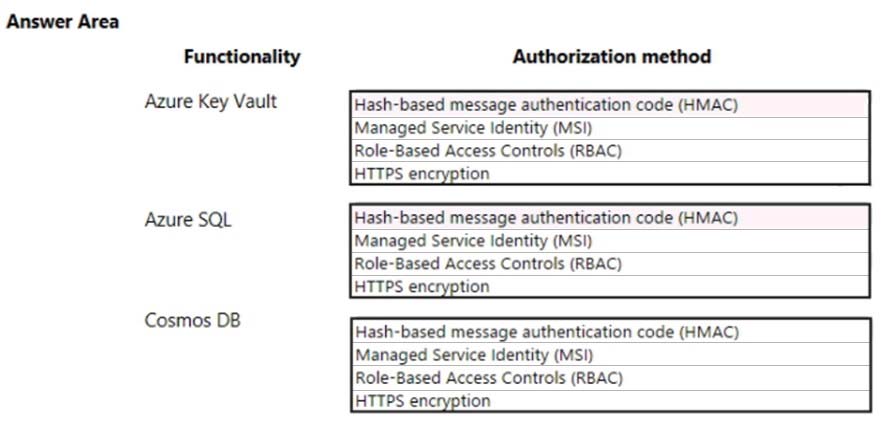
You use Azure Application Insights.
You plan to use continuous export.
You need to store Application Insights data for five years.
Which Azure service should you use?A. Azure SQL Database
B. Azure Storage
C. Azure Monitor Logs
D. Azure Backup
Note: This question is part of series of questions that present the same scenario. Each question in the series contains a unique solution that might meet the stated goals. Some question sets might have more than one correct solution, while others might not have a correct solution.
After you answer a question in this section, you will NOT be able to return to it. As a result, these questions will not appear in the review screen.
You have an Azure subscription that contains a resource group named RG1.
You create an Azure Active Directory (Azure AD) group named ResearchUsers that contains the user accounts of all researchers.
You need to recommend a solution that meets the following requirements:
✑ The researchers must be allowed to create Azure virtual machines.
✑ The researchers must only be able to create Azure virtual machines by using specific Azure Resource Manager templates.
Solution: On RG1, assign a custom role-based access control (RBAC) role to the ResearchUsers group.
Does this meet the goal?A. Yes
B. No
Your network contains an on-premises Active Directory forest.
You discover that when users change jobs within your company, the membership of the user groups are not being updated. As a result, the users can access resources that are no longer relevant to their job.
You plan to integrate Active Directory and Azure Active Directory (Azure AD) by using Azure AD Connect.
You need to recommend a solution to ensure that group owners are emailed monthly about the group memberships they manage.
What should you include in the recommendation?A. Azure AD access reviews
B. Tenant Restrictions
C. Azure AD Identity Protection
D. conditional access policies
You have an on-premises application named App1 that uses an Oracle database.
You plan to use Azure Databricks to load data from App1 to an Azure SQL Data Warehouse instance.
You need to ensure that the App1 data is available to Databricks.
Which two Azure services should you include in the solution? Each correct answer presents part of the solution.
NOTE: Each correct selection is worth one point.A. Azure Import/Export service
B. Azure Data Box Gateway
C. Azure Data Box Edge
D. Azure Data Lake Storage
E. Azure Data Factory
HOTSPOT -
You need to recommend a solution for the data store of the historical transaction query system.
What should you include in the recommendation? To answer, select the appropriate options in the answer area.
NOTE: Each correct selection is worth one point.
Hot Area:
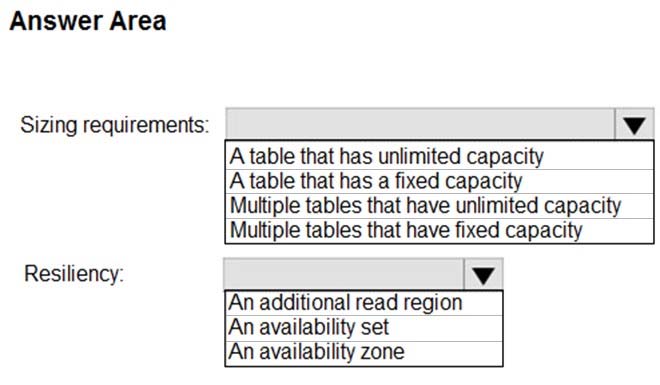
You have an on-premises deployment of MongoDB.
You plan to migrate MongoDB to an Azure Cosmos DB account that uses the MongoDB API.
You need to recommend a solution for migrating MongoDB to Azure Cosmos DB.
What should you include in the recommendation?A. mongorestore
B. Data Migration Assistant
C. Azure Storage Explorer
D. Azure Cosmos DB Data Migration Tool
You plan to create an Azure Cosmos DB account that uses the SQL API. The account will contain data added by a web application. The web application will send data daily.
You need to recommend a notification solution that meets the following requirements:
✑ Sends email notification when data is received from IoT devices.
✑ Minimizes compute cost.
What should you include in the recommendation?A. Deploy an Azure logic app that has the Azure Cosmos DB connector configured to use a SendGrid action.
B. Deploy a function app that is configured to use the Consumption plan and a SendGrid binding.
C. Deploy an Azure logic app that has a SendGrid connector configured to use an Azure Cosmos DB action.
D. Deploy a function app that is configured to use the Consumption plan and an Azure Event Hubs binding.
You need to recommend a solution to generate a monthly report of all the new Azure Resource Manager resource deployments in your subscription.
What should you include in the recommendation?A. Azure Analysis Services
B. Azure Activity Log
C. Azure Monitor action groups
D. Azure Advisor
E. Azure Monitor metrics
F. Azure Log Analytics
G. Application Insights
You manage on-premises networks and Azure virtual networks.
You need a secure private connection between the on-premises networks and the Azure virtual networks. The connection must offer a redundant pair of cross connections to provide high availability.
What should you recommend?A. ExpressRoute
B. Azure Load Balancer
C. virtual network peering
D. VPN Gateway
Note: This question is part of series of questions that present the same scenario. Each question in the series contains a unique solution that might meet the stated goals. Some question sets might have more than one correct solution, while others might not have a correct solution.
After you answer a question in this section, you will NOT be able to return to it. As a result, these questions will not appear in the review screen.
Your company has deployed several virtual machines (VMs) on-premises and to Azure. Azure ExpressRoute has been deployed and configured for on-premises to Azure connectivity.
Several VMs are exhibiting network connectivity issues.
You need to analyze the network traffic to determine whether packets are being allowed or denied to the VMs.
Solution: Use Azure Advisor to analyze the network traffic.
Does the solution meet the goal?A. Yes
B. No
You need to recommend a strategy for migrating the database content of WebApp1 to Azure.
What should you include in the recommendation?A. Use Azure Site Recovery to replicate the SQL servers to Azure
B. Use SQL Server transactional replication
C. Copy the VHD that contains the Azure SQL database files to Azure Blob storage
D. Copy the BACPAC file that contains the Azure SQL database files to Azure Blob storage
HOTSPOT -
You are designing an access policy for the sales department at your company.
Occasionally, the developers at the company must stop, start, and restart Azure virtual machines. The development team changes often.
You need to recommend a solution to provide the developers with the required access to the virtual machines. The solution must meet the following requirements:
✑ Provide permissions only when needed.
✑ Use the principle of least privilege.
Minimize costs.
What should you include in the recommendation? To answer, select the appropriate options in the answer area.
NOTE: Each correct selection is worth one point.
Hot Area:
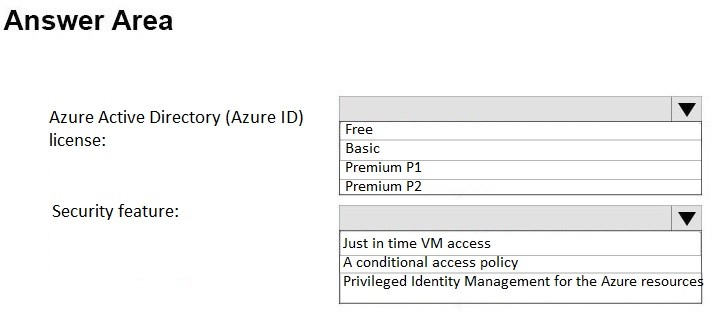
HOTSPOT -
You have an Azure subscription that contains 300 Azure virtual machines that run Windows Server 2016.
You need to centrally monitor all warning events in the System logs of the virtual machines.
What should you include in the solutions? To answer, select the appropriate options in the answer area.
NOTE: Each correct selection is worth one point.
Hot Area:

HOTSPOT -
You manage a network that includes an on-premises Active Directory Domain Services domain and an Azure Active Directory (Azure AD).
Employees are required to use different accounts when using on-premises or cloud resources. You must recommend a solution that lets employees sign in to all company resources by using a single account. The solution must implement an identity provider.
You need provide guidance on the different identity providers.
How should you describe each identity provider? To answer, select the appropriate description from each list in the answer area.
NOTE: Each correct selection is worth one point.
Hot Area:
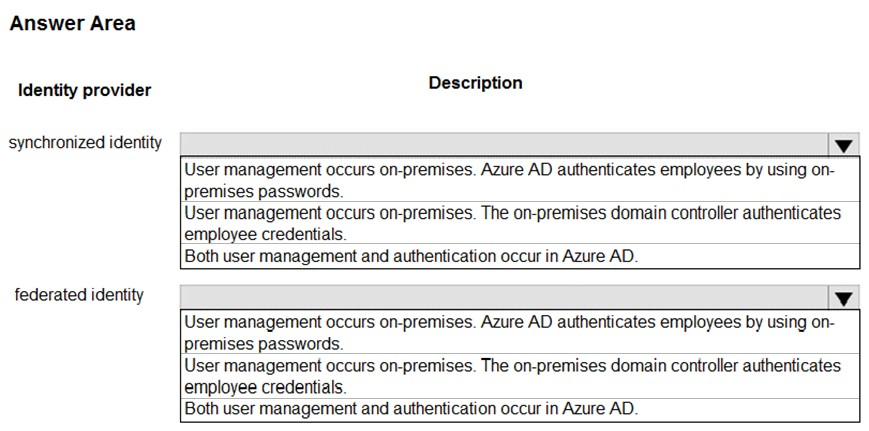
Note: This question is part of series of questions that present the same scenario. Each question in the series contains a unique solution that might meet the stated goals. Some question sets might have more than one correct solution, while others might not have a correct solution.
After you answer a question in this section, you will NOT be able to return to it. As a result, these questions will not appear in the review screen.
You are designing an Azure solution for a company that has four departments. Each department will deploy several Azure app services and Azure SQL databases.
You need to recommend a solution to report the costs for each department to deploy the app services and the databases. The solution must provide a consolidated view for cost reporting.
Solution: Create a new subscription for each department.
Does this meet the goal?A. Yes
B. No
Free Access Full AZ-301 Practice Test Free Questions
If you're looking for more AZ-301 practice test free questions, click here to access the full AZ-301 practice test.
We regularly update this page with new practice questions, so be sure to check back frequently.
Good luck with your AZ-301 certification journey!


